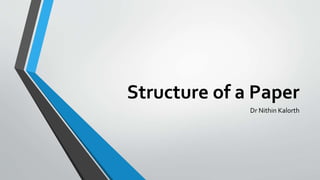
Structure of a research paper
- 1. Structure of a Paper Dr Nithin Kalorth
- 2. Paper/Article/Work • Short Communication • Review Papers • Essay/Research Elements/Video/Interview • Full Articles • Book Reviews (Not in Scopus) • Case and Policy Papers
- 3. Valuating a Journal • Unpaid or Paid • APC • Open Source • Conference Proceedings
- 4. Journal Impact • Indexing – SCOPUS, EBSCO, ABC, IEEE • Impact Factor – Citation/Total number ofArticles • Cite Score – Citation in a year/Total number ofArticles in 3 years • h Index - Most cited papers and the number of citations that they have received in other publications
- 5. Article • Title (8 – 10 words) • Abstract and KeyWords (200 – 250 words) • Introduction (500 – 1000 words) • Literature Review (1ooo – 2000 words) • Methods and Methodology (500 – 1000 words) • Findings (1000 – 1500 words) • Discussion (1000 – 1500 words) • References • Total (4000 – 7000 words)
- 6. Title of the Paper • Title should be reflect the main theme. • Some of keywords of paper should appear in title. • There should be no full stop after title. • Title expects to provide answers to: • What will be studied/researched? • How will be researched? • With who and where it researched?
- 7. Keys elements in Abstract • Element 1: Start with key problem/ theme of the paper. • Element 2: Main purpose/aim of the study • Element 3: Importance of Study • Element 4: Methodology used • Element 5: Main findings/Expected findings • Element 6: Statement of Conclusion/Implications of study
- 8. Starting with introduction • Element 1: State broad theme or topic of the paper. • Element 2: Academic importance or relevance (Why my paper is worth a read) • Element 3: Summarize available literature and cite important studies in the field. • Element 4: Main gaps of the paper or main contribution of the paper. • Element 5: Research Questions/Context/Theoretical Framework/Method • Element 6: Structure of upcoming sessions.
- 9. Writing Introduction • Start with simple language without jargons. • Keep in mind you are giving paper to unprepared reader. • Use examples to explain technical words or concepts. • Academic Importance = No/less previous work but enough practical work/evidence.
- 10. Writing Literature • Theoretical Core of the paper • Critically evaluates, re-organises, and synthesises the work of other researchers. • Digest information from various sources and present in logical and reader friendly manner.
- 11. Critical Integration and Synthesis Articl e 3 Article 1 Article 2 Literature Review
- 12. Three challenges of Literature Review • Finding suitable literature on a specific topic. • Managing information • Presenting logical, synthesised, reader friendly review of current knowledge.
- 15. Organizing Literature Review • Start with general/wider concepts. • Plan headings and sub-headings. • Write in full sentence – by using a verb. • Write in active voice. • Use less direct quote. • Paraphrase and explain in your own words. • In text citations.
- 16. Word by word; paragraph by paragraph • The topic –The main subject matter or idea covered in the paragraph • The controlling idea –This idea focuses the topic by providing direction to the composition. • Demonstrate your point. • One idea in a paragraph. • Link previous and upcoming paragraphs.
